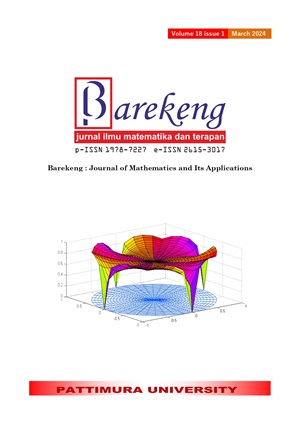ANALYSIS AND SIMULATION OF THE SIR MODEL ON THE SPREAD OF COVID-19 BY CONSIDERING THE VACCINATION FACTOR
Abstract
Covid-19 is a serious respiratory disease that can be fatal for those affected. Governments have tried various strategies to conquer the Covid-19 pandemic. One of them is to vaccinate people with 6 years old and over. The vaccination program aims to form herd immunity so that the number of confirmed positive cases can be reduced. The purpose of this research is to form a mathematical model of the SIR (Susceptible-Infected-Recovery) spread of Covid-19 by considering vaccination factors. The SIR model is combined with a vaccination factor to forestall the unfold of Covid-19. The research method includes deriving models of nonlinear differential equation systems, solving qualitative models, deriving the basic reproduction ratio ( ), analysis of equilibrium points, and building simulation models. This model has an asymptotically stable disease-free equilibrium point. At the same time, the endemic equilibrium point is unstable. Model simulation is obtained by using different parameter values. This is proven through the outcomes of the model analysis vaccination coverage is a key parameter that can be controlled to reduce so that the pandemic ends soon.
Downloads
References
T. Hu, Y. Liu, M. Zhao, Q. Zhuang, L. Xu, and Q. He, “A comparison of COVID-19, SARS and MERS,” PeerJ, vol. 8, pp. 1–30, 2020.
C. Siemaszko, “Coronavirus outbreak labeled a pandemic by World Health Organization,” 2020. [Online]. Available: https://www.nbcnews.com/health/health-news/coronavirus-outbreak-labeledpandemic-world-health-organization-n1155741. [Accessed: 27-Mar-2020].
N. Mascie Taylor and K. Moji, “Pandemics,” J. Peace Nucl. Disarm., vol. 4, no. S1, pp. 47–59, 2021.
W. H. Organization, “QA for Public,” 2020. [Online]. Available: https://www.who.int/indonesia/news/novel-coronavirus/qa-for-public. [Accessed: 05-Sep-2020].
M. Sukmana and F. A. Yuniarti, “The Pathogenesis Characteristics and Symptom of Covid-19 in the Context of Establishing a Nursing Diagnosis,” J. Kesehat. Pasak Bumi Kalimantan, vol. 3, no. 1, p. 21, 2020.
A. Kurniawati, “The Impact of COVID-19 Pandemic on Learning in Indonesia,” J. Media Komun. Pendikan Teknol. dan Kejuru., vol. 8, no. 2, pp. 16–21, 2021.
L. Saryani and A. Sayuti Pulungan, “Impact Of The Covid-19 Pandemic On The Indonesian Economy,” Int. J. Educ. Res. Soc. Sci., vol. 2, no. 5, pp. 996–1007, 2021.
L. Mery, A. Rahmah, and A. S. R. Wulandari, “Regulation of The Provision of Covid-19 Vaccination in Indonesia as The Implementation of State Obligations in line with The Indonesian Constitution,” Sasi, vol. 27, no. 4, p. 451, 2021.
A. Afzal, C. A. Saleel, S. Bhattacharyya, N. Satish, O. D. Samuel, and I. A. Badruddin, “Merits and Limitations of Mathematical Modeling and Computational Simulations in Mitigation of COVID-19 Pandemic: A Comprehensive Review,” Arch. Comput. Methods Eng., vol. 29, no. 2, pp. 1311–1337, 2022.
B. A. Wahyudi and I. Palupi, “Prediction of the peak Covid-19 pandemic in Indonesia using SIR model,” J. Teknol. dan Sist. Komput., vol. 9, no. 1, pp. 49–55, 2021.
A. P. Putra and S. A. Z. Abidin, “Aplication of SEIR Model in Covid-19 and the Effect of Lockdown on Reducing The Number of Active Cases,” vol. 5, no. 2, pp. 185–192, 2020.
U. M. Rifanti, A. R. Dewi, N. Nurlaili, and S. T. Hapsari, “Model Matematika COVID-19 dengan Sumber Daya Pengobatan yang Terbatas,” Limits J. Math. Its Appl., vol. 18, no. 1, p. 23, 2021.
N. Aulia and M. Kharis, “Pemodelan Matematika Epidemi Influenza Dengan Memperhatikan Peluang Keberhasilan Vaksinasi Dan Kekebalan Tetap,” J. Math. UNNES, vol. 5, no. 2, 2016.
M. Abdy, S. Side, S. Annas, W. Nur, and W. Sanusi, “An SIR epidemic model for COVID-19 spread with fuzzy parameter: the case of Indonesia,” Adv. Differ. Equations, vol. 2021, no. 1, 2021.
S. I. Vinitsky, A. A. Gusev, V. L. Derbov, P. M. Krassovitskiy, F. M. Pen’kov, and G. Chuluunbaatar, “Reduced SIR Model of COVID-19 Pandemic,” Comput. Math. Math. Phys., vol. 61, no. 3, pp. 376–387, 2021.
M. Imran, M. Wu, Y. Zhao, E. Beşe, W. Alonazi, and M. J. Khan, “Mathematical Modelling of SIR for COVID-19 Forecasting,” Rev. Argentina Clínica Psicológica, vol. XXX, pp. 218–226, 2021.
S. Annas, M. Isbar Pratama, M. Rifandi, W. Sanusi, and S. Side, “Stability analysis and numerical simulation of SEIR model for pandemic COVID-19 spread in Indonesia,” Chaos, Solitons and Fractals, vol. 139, 2020.
M. N. Alenezi, F. S. Al-Anzi, and H. Alabdulrazzaq, “Building a sensible SIR estimation model for COVID-19 outspread in Kuwait,” Alexandria Eng. J., vol. 60, no. 3, pp. 3161–3175, 2021.
X. Liu, “A simple, SIR-like but individual-based epidemic model: Application in comparison of COVID-19 in New York City and Wuhan,” Results Phys., vol. 20, no. August 2020, 2021.
W. . Boyce and R. . DiPrima, Elementary Differential Equations with Boundary Value Problems, 10th ed. New Jersey : Prentice-Hall, 2012.
[BPS] Badan Pusat Statistik, “Berita resmi statistik,” Bps.Go.Id, no. 27, pp. 1–52, 2019.
Kemenkes, “Dashboard Covid-19,” Covid-19, 2021. [Online]. Available: https://dashboardcovid19.kemkes.go.id/. [Accessed: 20-May-2021].
Copyright (c) 2024 Atika Ratna Dewi, Ridho Ananda, Utti Marina Rifanti, Nadia Putri Anggraeni, Miko Ardian

This work is licensed under a Creative Commons Attribution-ShareAlike 4.0 International License.
Authors who publish with this Journal agree to the following terms:
- Author retain copyright and grant the journal right of first publication with the work simultaneously licensed under a creative commons attribution license that allow others to share the work within an acknowledgement of the work’s authorship and initial publication of this journal.
- Authors are able to enter into separate, additional contractual arrangement for the non-exclusive distribution of the journal’s published version of the work (e.g. acknowledgement of its initial publication in this journal).
- Authors are permitted and encouraged to post their work online (e.g. in institutional repositories or on their websites) prior to and during the submission process, as it can lead to productive exchanges, as well as earlier and greater citation of published works.






1.gif)



